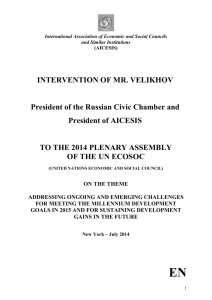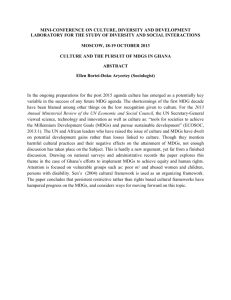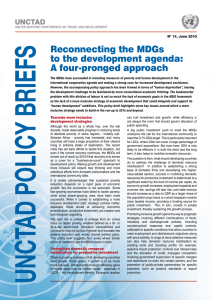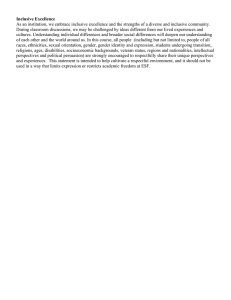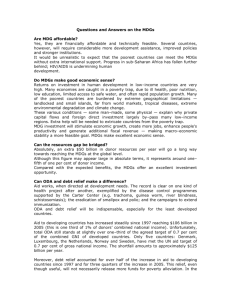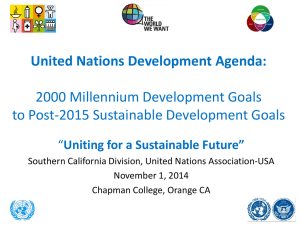Presentation by Mr. Zia Qureshi, Senior Advisor to the Chief Economist, World Bank, on Global Monitoring Report 2008
advertisement
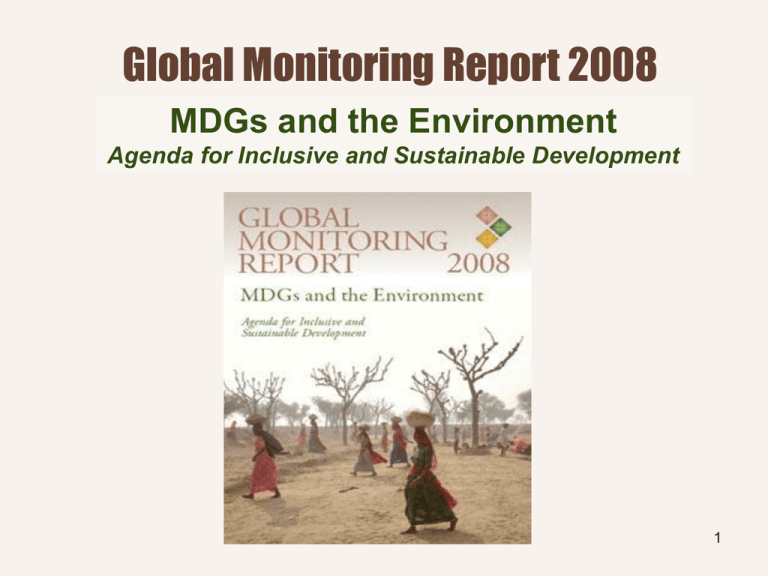
Global Monitoring Report 2008 MDGs and the Environment Agenda for Inclusive and Sustainable Development 1 World on track on poverty reduction and gender parity at school MDGs, but serious shortfalls likely on nutrition, education, health, and sanitation goals d 2 Africa lags on all MDGs, South Asia on most human development goals. At country level, most countries are off track to meet most MDGs 3 Progress toward MDGs slowest in fragile states— even negative on some MDGs 4 Agenda ahead • Assessment at midpoint shows urgent need to generate stronger, more inclusive momentum toward the MDGs • With stronger efforts by countries and by development partners, most MDGs still achievable for most countries • As MDG 7 underscores, development and environmental sustainability are integrally linked • In this Year of Action for MDGs, need to agree on priority actions and milestones for monitoring progress • Report emphasizes a six-point agenda for inclusive and sustainable development 5 MDGs and the environment: A six-point agenda for inclusive and sustainable development • Sustain and broaden the growth momentum • Achieve better results in human development • Integrate development and environmental sustainability • Scale up aid and increase its effectiveness • Harness trade for strong, inclusive, and sustainable growth • Leverage IFI support for inclusive and sustainable development 6 Increased risks from financial turbulence— developing-country growth slowing but still robust annual % change 8 6 4 2 0 World output 2007 Advanced economies 2008 (Projected) Emerging market and developing countries Africa 2009 (Projected) 7 Private capital flows expected to ease but remain relatively abundant Net private capital flows to developing countries $ billions Percent $1 trillion in 2007 1000 8 800 6 Percent of GDP (right axis) 600 4 400 2 200 0 0 1990 1992 1994 1996 1998 2000 2002 2004 2006 2008P 8 Sharp rises in energy and food prices add to risks Commodity Price Index (1990=100) 500 400 300 200 100 0 1990 1992 1994 grains 1996 1998 raw materials 2000 2002 metals 2004 2006 2008 energy 9 Growth in Africa has improved, but varies widely across countries 10 Growth needs to be more inclusive— both across and within countries Annual change in Gini coefficient in 59 developing countries 11 More but better spending on education and health Public spending on education and health typically favors the rich 12 Stronger focus needed on combating malnutrition—higher food prices increase urgency Incidence of stunting remains high in low-income countries 13 Environmental health risks—a significant concern Economic burden of poor environmental health can be high— 1.5-4% of GDP annually 14 Deforestation causes loss of forest equivalent in size to Panama or Sierra Leone every year Annual deforestation by region and income group, 2000-05 15 Developing countries are most vulnerable to climate change and least able to adapt Impact of climate change on agricultural yields, 2079-99 16 Mitigation calls for common but differentiated responsibilities Per capita GHG emissions (including from land use change), 2000 17 Global Environmental SustainabilityOne Size Does Not Fit All High income countries Provide global public goods – e.g. Kyoto and beyond High deforestation countries (e.g. Brazil) – Eliminate perverse incentives, improve governance Biodiversity rich countries (e.g. Peru) – Conserve natural areas, tap global finance for conservation, develop ecotourism High child mortality countries (e.g. Mali) Provide water and sanitation, improve access to electricity Countries in transition (e.g. Ukraine) Increase energy efficiency and control pollution Rapidly growing countries (e.g. China, India) Reduce carbon intensity of growth AgricultureIncreasing water dependent scarcity (e.g. MNA) countries (e.g. Increase water use Ethiopia) efficiency, define Manage land and water use rights water resources, diversify assets Sub-soil resource rich countries (e.g. Mozambique) Invest resource rents, improve governance Rapidly urbanizing countries (e.g. Vietnam) Manage pollution from transport and industry 18 Countries’ absorptive capacity rising, but aid falling DAC members’ net ODA flows 2005 US$ (billions) ODA as % of GNI 150 0.4 0.35 120 0.3 0.25 90 0.2 60 0.15 0.1 30 0.05 0 0 1990 1992 1994 1996 1998 ODA as a % of GNI 2000 2002 2004 2006 2008 Total net ODA 19 Time to deliver on aid commitments is now Most of the promised increase in aid has not yet materialized 2004 US$ billions 150 Total Net ODA Net ODA to SSA 120 90 60 30 0 All DAC donors G7 donors 2004 2007 All DAC donors G7 donors 2010 target* *Based on commitments made at Gleneagles and other donor commitments in 2005 20 Doha remains crucial Support to agriculture has not been declining Gross subsidy equivalents of assistance to farmers, 1960-2004 21 Increase aid for trade—to promote inclusiveness in exploitation of trade opportunities Aid for trade, average 2002-06 22 Trade policy should facilitate transfer of environmentally friendly technologies Environmental goods currently confront significant trade restrictiveness Trade Restrictiveness Index (%) 23 MDBs had record disbursements in 2007 Even as their relative financing role declines, international financial institutions’ impact through leverage remains key MDBs’ gross disbursements by type of flow and region, 2000-07 24 Issues for consideration at the meeting • What are the key elements of the agenda to achieve stronger and more inclusive growth, especially in Africa? • What challenges arise for developing countries from recent economic developments―financial market turmoil, global growth slowdown, and rise in energy and food prices―and how they may be addressed? • What actions are needed to scale up aid and ensure its effectiveness in a changing aid architecture and to leverage more private capital? • What measures are needed to enable countries to harness trade for strong, inclusive, and sustainable growth? • How can financing and technology transfer to developing countries be facilitated to help them achieve climate-resilient and low-carbon growth? 25
